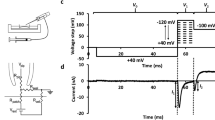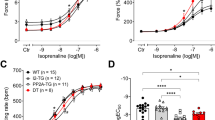Abstract
In the myocardium the inhibitory guanine nucleotide-binding regulatory proteins (Gi proteins) mediate negative chronotropic and negative inotropic effects by activation of K+ channels and inhibition of adenylyl cyclase. The concept of a uniform inhibitory action of Gi proteins on myocardial cellular activity has been questioned by the recent observations of adenosine-induced activation of the Na+/Ca2+ exchange and a carbachol-induced inhibition of the Na+/K+-ATPase activity in cardiac sarcolemmal membranes. The aim of the present study, therefore, was to reinvestigate the putative regulation of Na+/Ca2+ exchange and Na+/K+-ATPase activity in purified canine sarcolemmal membranes. These membranes were enriched in adenosine A1 (Maximum number of receptors, B max 0.033 pmol/mg) and muscarinic M2 (B max 2.9 pmol/mg) receptors and contained Gi2 and Gi3, two Gi protein isoforms, and Go, another pertussis toxin-sensitive G protein, as detected with specific antibodies. The adenosine A1-selective agonist, (−)-N 6-(2-phenylisopropyl)-adenosine, and the muscarinic agonist, carbachol, both inhibited isoprenaline-stimulated adenylyl cyclase activity by 25% and 35% respectively, and the stable GTP analogue 5′-guanylylimidodiphosphate inhibited forskolin-stimulated adenylyl cyclase activity by 35% in these membranes. The characteristics of Na+/Ca2+ exchange and Na+/K+-ATPase activity as well as those of the ouabain-sensitive, K+-activated 4-nitrophenylphosphatase, an ATP-independent, partial reaction of the Na+/K+-ATPase, were in agreement with published data with regard to specific activity, time course of activity and substrate dependency. However, none of these activities were influenced by adenosine, (−)-N 6-(2-phenylisopropyl)-adenosine, carbachol, or stable GTP analogs, suggesting that Na+/Ca2+ exchange and Na+/K+-ATPase are not regulated by Gi proteins in canine cardiac sarcolemmal membranes.
Similar content being viewed by others
References
Belardinelli L, Isenberg G (1983) Isolated atrial myocytes: adenosine and acetylcholine increase potassium conductance. Am J Physiol 244:H734-H737
Bigger JT Jr, Kleiger RE, Fleiss JL, Rolnitzky LM, Steinman RC, Miller JP (1988) The multicenter post-infarction research group. Components of heart rate variability measured during healing of acute myocardial infarction. Am J Cardiol 61:208–215
Billman GE (1990) Effect of carbachol and cyclic GMP on susceptibility to ventricular fibrillation. FASEB J 4:1668–1673
Both R (1992) Myocardial “stunning” in man. Circulation 86:1671–1691
Brechler V, Pavoine C, Lotersztajn S, Garbarz E, Pecker F (1990) Activation of Na+ Ca2+ exchange by adenosine in ewe heart sarcolemma is mediated by a pertussis toxin sensitive G protein. J Biol Chem 265:16851–16855
Cohen MV, Liu GS, Downey JM (1991) Preconditioning causes improved wall motion as well as smaller infarcts after transient coronary occlusion in rabbits. Circulation 84:341–349
Collins MN, Billman GE (1989) Autonomic response to coronary occlusion in animals susceptible to ventricular fibrillation. Am J Physiol 257:H1886-H1894
Colvin RA, Ashavaid TF, Herbette LG (1985) Structure-function studies of canine cardiac sarcolemmal membranes. I. Estimation of receptor site densities. Biochim Biophys Acta 812:601–608
Corr PB, Gillis RA (1974) Role of the vagus nerves in cardiovascular changes induced by coronary occlusion. Circulation 49:86–97
Corr PB, Witkowski FX, Sobel BE (1978) Mechanisms contributing to malignant dysrhythmias induced by ischemia in the cat. J Clin Invest 61:109–119
Danilenko MP, Panchenko MP, Yesirev OV, Tkachuk VA (1990) Involvement of pertussis-toxin-sensitive G protein in muscarinic-receptor-mediated inhibition of K+-activated 4-nitrophenylphosphatase activity of cardiac sarcolemma. Eur J Biochem 194:155–160
Eschenhagen T, Mende U, Nose M, Schmitz W, Scholz H, Schulte am Esch J, Sempell R, Warnholtz A, Wustel JM (1992) Regulation and possible functional implications of G-protein mRNA expression in nonfailing and failing ventricular myocardium. Basic Res Cardiol 87 (Suppl 1):51–64
Esmann M (1988) ATPase and phosphatase activity of Na+, K+-ATPase: molar and specific activity, protein determination. Methods Enzymol 156:105–115
Fiske CH, Subbarow Y (1925) The colorimetric determination of phosphorus. J Biol Chem 66:375–400
Forman MB, Velasco CE, Jackson EK (1993) Adenosine attenuates reperfusion injury following regional myocardial ischemia. Cardiovasc Res 27:9–17
Frank JS, Philipson KD, Beydler S (1984) Ultrastructure of isolated sarcolemma from dog and rabbit myocardium. Comparison to intact tissue. Circ Res 54:414–423
Holmer SR, Stevens S, Homcy CJ (1989) Tissue- and species-specific expression of inhibitory guanine nucleotide-binding proteins. Circ Res. 65:1136–1140
Jakobs KH, Saur W, Schultz G (1976) Reduction of adenylate cyclase activity in lysates of human platelets by the α-adrenergic component of epinephrine. J Cyclic Nucleotide Res 2:381–392
Jakobs KH, Aktories K, Schulz G (1979) GTP-dependent inhibition of adenylate cyclase by muscarinic cholinergic agonists. Naunyn-Schmiedeberg's Arch Pharmacol 310:113–119
Jones LR, Maddock SW, Besch HR Jr (1980) Unmasking effect of alamethicin on the (Na+, K+)-ATPase, β-adrenergic receptor-coupled adenylate cyclase, and cAMP-dependent protein kinase activities of cardiac sarcolemmal vesicles. J Biol Chem 255:9971–9980
Keung EC, Karliner JS (1990) Complex regulation of calcium current in cardiac cells. J Clin Invest 85:950–954
Kirsch GE, Codina J, Birnbaumer L, Brown AM (1990) Coupling of ATP-sensitive K+ channels to A1 receptors by G proteins in rat ventricular myocytes. Am J Physiol 259:H820–826
Kometiani ZP, Tsakadze LG, Jariashvili TY (1984) Functional significance of the effects of neurotransmitters of the Na+ K+-ATPase system. J Neurochem 42:1246–1250
Kurachi Y, Tung RT, Ho H, Nakajima T (1992) G-protein activation of cardiac muscarinic K+ channels. Prog Neurobiol 39:229–246
Kusuoka H, Camilion de Hurtado C, Marban E (1993) Role of sodium/calcium exchange in the mechanism of myocardial stunning: protective effect of reperfusion with high sodium solution. J Am Coll Cardiol 21:240–248
Lasley RD, Mentzer RM, Jr. (1993) Pertussis toxin blocks adenosine A1 receptor mediated protection of the ischaemic rat heart. J Mol Cell Cardiol 25:815–821
Lee KS, Yu DH (1963) A study of the sodium- and potassium activated adenosinetriphosphatase activity of heart microsomal fraction. Biochem Pharmacol 12:1253–1264
Linden J, Hollen CE, Patel A (1985) The mechanism by which adenosine and cholinergic agents reduce contractility in rat myocardium. Correlation with cyclic adenosine monophosphate and receptor densities. Circ Res 56:728–735
Matsuda JJ, Lee HC, Shibata EF (1993) Acetylcholine reversal of isoprenaline-stimulated sodium currents in rabbit ventricular myocytes. Circ Res 72:517–525
Murry CE, Jennings RB, Reimer KA (1986) Preconditioning with ischaemia: a delay of lethal cell injury in ischaemic myocardium. Circulation 74:1124–1136
Myers RW, Pearlman AS, Hyman RM, Goldstein RA, Kent KM, Goldstein RE, Epstein SE (1974) Beneficial effects of vagal stimulation and bradycardia during experimental acute myocardial ischaemia. Circulation 49:943–947
Niroomand F, Weinbrenner C, Weis A, Bangert M, Schwencke C, Marquetant R, Beyer T, Strasser RH, Kübler W, Rauch B (1995) Impaired function of inhibitory G proteins during acute myocardial ischaemia of canine hearts and its reversal during reperfusion and a second period of ischaemia. Circ Res 76:861–870
Philipson KD, Nishimoto AY (1982) Na+-Ca2+ exchange in inside-out cardiac sarcolemmal vesicles. J Biol Chem 257:5111–5117
Reeves JP, Sutko JL (1979) Sodium-calcium ion exchnage in cardiac membrane vesicles. Proc Natl Acad Sci U S A 76:590–594
Robinson JD (1969) Kinetic studies on a brain microsomal adenosine triphosphatase. II. Potassium-dependent phosphatase activity. Biochemistry 8:3348–3355
Schulz R, Guth BD, Pieper K, Martin C, Heusch G (1992) Recruitment of an inotropic reserve in moderately ischaemic myocardium at the expense of metabolic recovery: a model of short term hibernation. Circ Res 70:1282–1295
Shiki H, Hearse DJ (1987) Preconditioning of ischaemic myocardium: reperfusion-induced arrhythmias. Am J Physiol 253:H1470-H1476
Skou JC (1979) Effects of ATP on the intermediary steps of the reaction of the (Na+ + K+)-ATPase. Biochim Biophys Acta 567:421–435
Skou JC (1988) Overview: the Na, K-pump. Methods Enzymol 156:1–25
Tani M, Neely JR (1991) Deleterious effects of digitalis on reperfusion-induced arrhythmias and myocardial injury in ischemic rat hearts: possible involment of myocardial Na+ and Ca2+ imbalance. Basic Res Cardiol 86:340–354
Thornton JD, Liu GS, Downey JM (1993) Pretreatment with pertussis toxin blocks the protective effects of preconditioning: evidence for a G-protein mechanism. J Mol Cell Cardiol 25:311–320
Zuanetti G, Ferrari GM De, Priori SG, Schwartz PJ (1987) Protective effect of vagal stimulation on reperfusion arrhythmias in cats. Circ Res 61:429–435
Author information
Authors and Affiliations
Rights and permissions
About this article
Cite this article
Mura, R.A., Zeifang, F., Piacentini, L. et al. Evidence against a regulation of Na+/K+-ATPase by Gi proteins. Failure to detect an influence of G proteins on Na+/Ca2+-exchange in cardiac sarcolemmal membranes. Naunyn-Schmiedeberg's Arch Pharmacol 353, 505–512 (1996). https://doi.org/10.1007/BF00169169
Received:
Accepted:
Issue Date:
DOI: https://doi.org/10.1007/BF00169169




